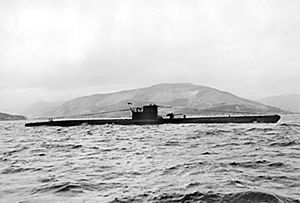German submarine U-773 facts for kids

U-570 Type VIIC submarine that was captured by the British in 1941. This U-boat is almost identical to U-773.
|
|
Quick facts for kids History |
|
|---|---|
| Name | U-773 |
| Ordered | 21 November 1940 |
| Builder | Kriegsmarinewerft, Wilhelmshaven |
| Yard number | 156 |
| Laid down | 13 October 1942 |
| Launched | 8 December 1943 |
| Commissioned | 20 January 1944 |
| Fate | Surrendered on 9 May 1945; sunk as part of Operation Deadlight on 8 December 1945 |
| General characteristics | |
| Class and type | Type VIIC submarine |
| Displacement |
|
| Length |
|
| Beam |
|
| Height | 9.60 m (31 ft 6 in) |
| Draught | 4.74 m (15 ft 7 in) |
| Installed power |
|
| Propulsion |
|
| Speed |
|
| Range | |
| Test depth |
|
| Complement | 4 officers, 44–52 enlisted |
| Armament |
|
| Service record | |
| Part of: |
|
| Commanders: |
|
| Operations: |
|
| Victories: | None |
U-773 was a German submarine used during World War II. It was a Type VIIC U-boat, a common kind of submarine built by Nazi Germany's navy, the Kriegsmarine.
The order to build U-773 was given on 21 November 1940. Construction began on 13 October 1942, at Kriegsmarinewerft in Wilhelmshaven. The submarine was officially launched on 8 December 1943. It was then put into service on 20 January 1944, under the command of Oberleutnant zur See Richard Lange.
Contents
Submarine Design and Features
German Type VIIC submarines were a very important type of U-boat. They were designed to be better than earlier models.
U-773 weighed about 769 tonnes (757 long tons) when it was on the surface. When it was underwater, it weighed about 871 tonnes (857 long tons). The submarine was 67.10 m (220 ft 2 in) long in total. Its strong inner hull, called the pressure hull, was 50.50 m (165 ft 8 in) long.
The submarine was 6.20 m (20 ft 4 in) wide and 9.60 m (31 ft 6 in) tall. It sat 4.74 m (15 ft 7 in) deep in the water.
Power and Speed
U-773 used two diesel engines when it was on the surface. These engines were very powerful. They helped the submarine travel at a top speed of 17.7 knots (32.8 km/h; 20.4 mph) (about 32.8 km/h).
When underwater, the U-boat switched to two electric motors. These motors allowed it to move quietly at up to 7.6 knots (14.1 km/h; 8.7 mph) (about 14.1 km/h).
The submarine could travel a long distance. On the surface, it could go 8,500 nautical miles (15,700 km; 9,800 mi) (about 15,742 km) at a speed of 10 knots (19 km/h; 12 mph). Underwater, it could travel 80 nautical miles (150 km; 92 mi) (about 148 km) at 4 knots (7.4 km/h; 4.6 mph).
Depth and Crew
U-773 was built to go deep underwater. It could safely operate at depths of up to 230 metres (750 ft) (about 755 feet). The submarine had a crew of between 44 and 52 sailors.
Weapons
U-773 was armed with several weapons. It had five 53.3 cm (21 in) torpedo tubes. Four of these were at the front (bow) and one was at the back (stern). It could carry 14 torpedoes or 26 mines.
For fighting on the surface, it had an 8.8 cm (3.46 in) deck gun. It also had anti-aircraft guns to defend against planes. These included a 3.7 cm (1.5 in) Flak M42 gun and two twin 2 cm (0.79 in) anti-aircraft guns.
Service in World War II
U-773 went on three war patrols during World War II. However, it did not sink or damage any enemy ships during these missions.
Surrender and Sinking
As World War II was ending, U-773 surrendered on 9 May 1945. This happened in Lofjord, near Trondheim, Norway. The submarine was then moved to Loch Ryan, Scotland, on 29 May 1945.
U-773 was one of 116 U-boats chosen for Operation Deadlight. This was an operation where Allied forces sank captured German U-boats. On 8 December 1945, U-773 was towed out to sea and sunk. The exact reason for its sinking on that day is not known.
Today, the wreck of U-773 lies at 56°10′N 10°05′W / 56.167°N 10.083°W.

